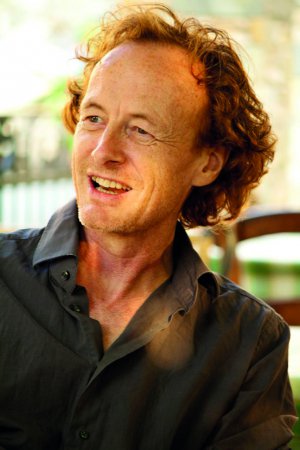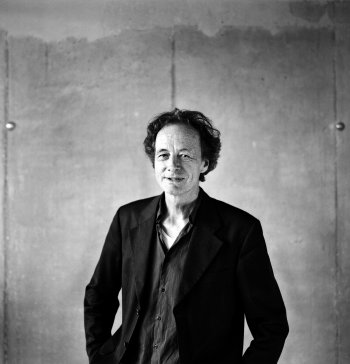Composer Portraits Series: Beat Furrer featuring Either/Or
Recent and new works by contemporary Swiss-Austrian avant-garde composer, played with virtuosity and integrity.

Beat Furrer (Photo credit: Dimitri Papageorgiou)
[avatar user=”Jean Ballard Terepka” size=”96″ align=”left” ] Jean Ballard Terepka, Music Critic[/avatar]Performed by contemporary music ensemble Either/Or, recent instrumental music by Beat Furrer (b. 1954) was featured in the most recent Composer Portraits series at Columbia University’s Miller Theatre. The oldest piece was Furrer’s popular spur for piano and string quartet (1998); two other pieces dated from 2012. Furrer’s Clarinet Quintet, intorno al bianco, completed in 2016, received its United States premiere. Although Beat Furrer was kept away from New York City by illness during the usual “residency” component of the Composer Portraits series, he nonetheless connected with the musicians by Skype.
The first half of the program consisted of the three older works. linea dell’orrizonte was presented by the full Either/Or complement of musicians — piano, clarinet, trumpet, trombone, violin, electric guitar, cello and percussion players — conducted by Richard Carrick. The 12-minute piece presented instruments’ convergences and separations, recognizable behaviors and blurry divergences; fiercely intense percussive rhythms managed to become liquid glissandi of high climbing and sudden down-swooping. A gradual density of sound felt like the makings of a conclusion until there was a sudden silence, a brief reengagement – something like a memory – and then a second, now final silence.
The second piece, Ira-Arca, a duet for bass flute and double bass, played by Margaret Lancaster and Ken Filiano was about relationships – samenesses, reflections, flirtations, followings and echoes – and about breathing. The music is written so as to make the instruments be both voices and breaths, and the musical sounds belong equally to the musicians’ bodies and their instruments. It is a surprising, satisfying piece, rewarding intellectually and viscerally.
spur (1998) finished the first half of the program. This well-known Furrer piece is inventive, containing a wide range of affect, from grand to comic, in its devilishly difficult fast-paced changes.
The entire second half of the program consisted of intorno al bianco. Clarinettist Vasko Dukovski and the string quartet – Jennifer Choi/violin, Pala Garcia/violin, Erin Wight/viola and John Popham/cello – made a splendid, organic chamber group. More than the other works on the program, this most recent work had elements of old-fashioned loveliness to it as well a single overarching architectural movement: the work moved from sounds that only gradually formed themselves into music, then created volume and densely complex internal patterns, and then faded off again into a richly tender quiet of memory and the wisdom of an intensely lived experience.
Especially because the distinct structural feel of this new piece was so different from the older works, Beat Furrer’s absence was an unhappy chance: the presence of composers for discussions is an important feature of the Composer Portraits series, and conversation with Furrer on this particular evening would have been welcome.

Beat Furrer (Photo credit: David Furrer)
Beat Furrer’s instrumental music makes complex demands on the musicians who play it and on its listeners: without anchor in perceptible historical narrative, it requires an engagement in definitions. Furrer takes traditional instruments – piano, violin, flute, clarinet, for instance – and identifies their defining elements: he separates out their various sound possibilities and matches these with musicians’ skills, techniques, abilities and energies. The instruments’ possibilities themselves are, in this process, reassessed. Sounds’ relationships – familiar and felicitous; experimental and ahistorical – are reexamined. Notes and chords are returned to their origins, released from later prescriptions and expectations, and placed so as to explore new relationships.
Throughout these Furrer pieces, the development, exploration, recasting and questioning of musical relationships are the constant themes. Rhythms are set long enough to be recognizable and are then shifted; textures are constantly being recrafted; music moves fluidly, then percussively, flowingly again and then nervously and gingerly.
This is serious work. Without defiance of traditional or conservative contemporary classical music simply for mere defiance’s haughty sake, Furrer is developing his own particular vocabulary. And successful performance of Furrer’s music requires serious musicians. The musicians of Either/Or are a good match for this composer. Their technical skills are superb, marked by both muscular stamina and virtuosic creativity; equally important, their willingness to take performance risks is grounded in intellectual and artistic integrity.
In Paul Griffiths’ typically useful and excellent program notes, Furrer is quoted directly. “Composing would not interest me,” he said, “if I had the impression that I was reproducing a well-worn concept rather than taking a step in a new direction.”
Furrer’s new steps in new directions are interesting and exciting; Either/Or presents them well. This was a fine concert; if New York City audiences are lucky, Beat Furrer will be back soon.
Beat Furrer: Either/Or (February 2, 2017)
Composer Portraits Series
Miller Theatre at Columbia University School of the Arts
2960 Broadway at 116th Street, in Manhattan
For information, visit http://www.millertheatre.com or http://www.beatfurrer.com
Running time: one hour and 50 minutes with one intermission






Leave a comment